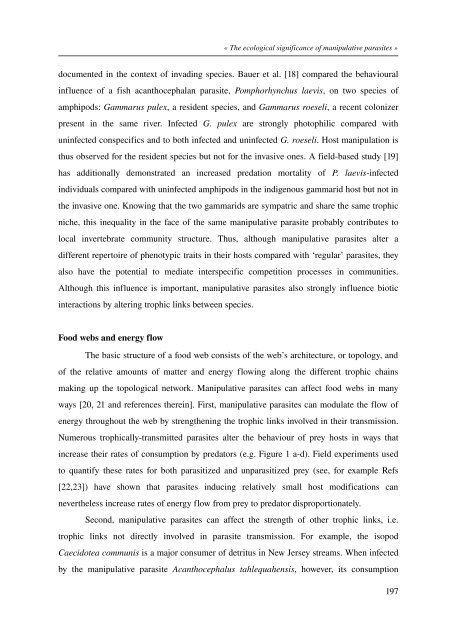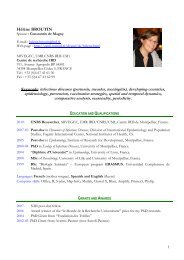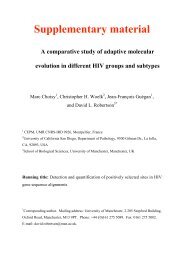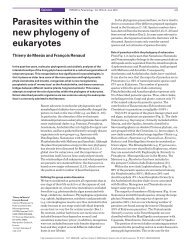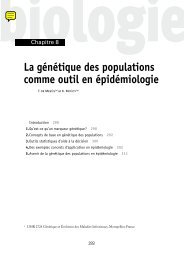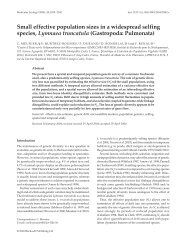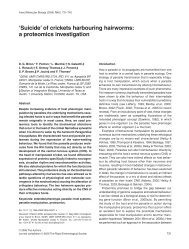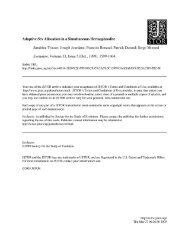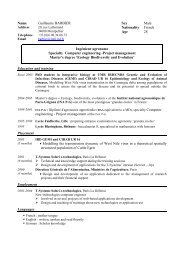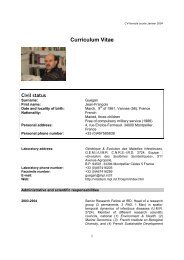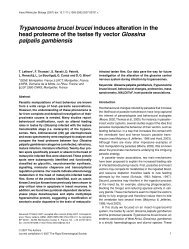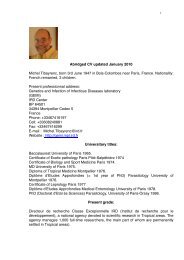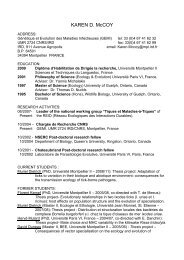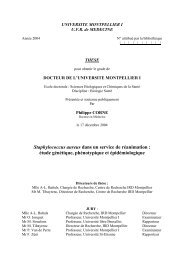écologie des virus influenza aviaires en Camargue - IRD
écologie des virus influenza aviaires en Camargue - IRD
écologie des virus influenza aviaires en Camargue - IRD
You also want an ePaper? Increase the reach of your titles
YUMPU automatically turns print PDFs into web optimized ePapers that Google loves.
« The ecological significance of manipulative parasites »docum<strong>en</strong>ted in the context of invading species. Bauer et al. [18] compared the behaviouralinflu<strong>en</strong>ce of a fish acanthocephalan parasite, Pomphorhynchus laevis, on two species ofamphipods: Gammarus pulex, a resid<strong>en</strong>t species, and Gammarus roeseli, a rec<strong>en</strong>t colonizerpres<strong>en</strong>t in the same river. Infected G. pulex are strongly photophilic compared withuninfected conspecifics and to both infected and uninfected G. roeseli. Host manipulation isthus observed for the resid<strong>en</strong>t species but not for the invasive ones. A fieldbased study [19]has additionally demonstrated an increased predation mortality of P. laevisinfectedindividuals compared with uninfected amphipods in the indig<strong>en</strong>ous gammarid host but not inthe invasive one. Knowing that the two gammarids are sympatric and share the same trophicniche, this inequality in the face of the same manipulative parasite probably contributes tolocal invertebrate community structure. Thus, although manipulative parasites alter adiffer<strong>en</strong>t repertoire of ph<strong>en</strong>otypic traits in their hosts compared with ‘regular’ parasites, theyalso have the pot<strong>en</strong>tial to mediate interspecific competition processes in communities.Although this influ<strong>en</strong>ce is important, manipulative parasites also strongly influ<strong>en</strong>ce bioticinteractions by altering trophic links betwe<strong>en</strong> species.Food webs and <strong>en</strong>ergy flowThe basic structure of a food web consists of the web’s architecture, or topology, andof the relative amounts of matter and <strong>en</strong>ergy flowing along the differ<strong>en</strong>t trophic chainsmaking up the topological network. Manipulative parasites can affect food webs in manyways [20, 21 and refer<strong>en</strong>ces therein]. First, manipulative parasites can modulate the flow of<strong>en</strong>ergy throughout the web by str<strong>en</strong>gth<strong>en</strong>ing the trophic links involved in their transmission.Numerous trophicallytransmitted parasites alter the behaviour of prey hosts in ways thatincrease their rates of consumption by predators (e.g. Figure 1 ad). Field experim<strong>en</strong>ts usedto quantify these rates for both parasitized and unparasitized prey (see, for example Refs[22,23]) have shown that parasites inducing relatively small host modifications cannevertheless increase rates of <strong>en</strong>ergy flow from prey to predator disproportionately.Second, manipulative parasites can affect the str<strong>en</strong>gth of other trophic links, i.e.trophic links not directly involved in parasite transmission. For example, the isopodCaecidotea communis is a major consumer of detritus in New Jersey streams. Wh<strong>en</strong> infectedby the manipulative parasite Acanthocephalus tahlequah<strong>en</strong>sis, however, its consumption197


